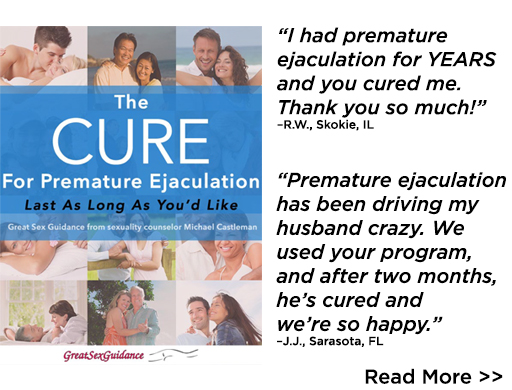
Behind “that clean, fresh feeling” touted in ads for feminine hygiene products is a nasty implication women fear—the mistaken notion that the vagina is a dirty, malodorous organ. But the ads have struck a nerve. According to the Centers for Disease Control and Prevention (CDC), they have persuaded an estimated 15 percent of U.S. women to douche regularly. Some use home-made water-vinegar douches, but most spring for disposable, commercial products that ring up sales of $150 million a year. Douche ads have also persuaded many mothers to advise their daughters to douche regularly.
Douching Is Not Necessary, It’s Also Harmful
What the ads don’t mention is that douching is not only unnecessary, it’s also surprisingly harmful. The healthy vagina contains a variety of bacteria that have complex relationships with one another. Within 10 minutes of douching, some of these bacteria get killed off, which upsets the ecological balance. The vaginal micro-environment reverts to normal within 72 hours. But before it does, bacteria no longer held in check by those that have been killed off may multiply to the point that they cause a variety of infections:
Bacterial Vaginosis (BV)
Many women douche for fear that their vaginas smell bad. Ironically, douching increases risk of bacterial vaginosis, an infection that causes an unpleasant fishy-smelling discharge and other symptoms. University of Pittsburgh researchers surveyed 1,200 reproductive age women. As douching increased, so did risk of BV. Compared with those who did not douche at all, women who douched once a month, were 40 percent more likely to develop BV. In those who douched weekly, BV risk doubled.
Trichomonas
Trichomonas is a common vaginal infection. CDC researchers tested 3,754 women, aged 14 to 49. Three percent had trichomonas. Compared with those who remained free of trichomonas, women who douched regularly were significantly more likely to be infected.
Chlamydia
Chlamydia is now the nation’s leading sexually transmitted infection. University of Washington researchers correlated douching and chlamydia risk in 1,692 women. Compared with those who never douched, those who did even once in the previous 12 months had double the risk of chlamydia. Those who douched weekly had almost four times the risk.
Yeast Infection
Italian researchers surveyed 931 women about their lifestyles, including douching, and their history of yeast infections. Frequent douching was associated with an increased risk of yeast infection.
Pelvic Inflammatory Disease (PID)
Chlamydia often causes no symptoms in women. As a result, in some cases, the infection progresses from the vagina through the cervix and into the uterus and fallopian tubes, where it causes pelvic inflammatory disease (PID), a serious infection that may threaten women’s fertility and possibly even their lives. In one study, researchers at Mount Sinai School of Medicine in New York City discovered that monthly douching almost doubled risk of PID. More frequent douching raised it even more. Compared with women who never douched, those who did so weekly had four times the risk of PID. Another study by researchers at University of Washington School of Medicine in Seattle compared the douching habits of 100 women hospitalized for PID and 762 healthy controls. Those with PID douched significantly more. Women who douched three times a month or more were 3.6 times more likely to develop PID.
Why would douching, which takes place in the vagina, be linked to PID, which infects the uterus and fallopian tubes? Researchers speculate that in addition to altering the micro-environment of the vagina, the douche stream pushes bacteria from the vagina into the uterus and fallopian tubes, where they cause PID.
Douching has also been linked to an increased risk of cancer:
Cervical Cancer
Researchers with the U.S. military’s Uniformed Services University of the Health Sciences in Bethesda, Maryland, investigated the douching habits of 266 Utah women who developed cervical cancer, and 408 very similar Utah women who did not. The study focused on Utah women because they were Mormon, a religion that forbids smoking and extramarital sex, both risk factors for cervical cancer. Compared with the nondouchers, those who douched more than once a week had four times the risk of cervical cancer.
Finally, douching has been linked to reproductive harm:
Infertility
Washington, D.C. researchers followed 840 married couples who were trying to get pregnant. After one year of unprotected intercourse, 10 percent of the women who never douched failed to conceive, but among women who douched weekly, 27 percent did not.
Ectopic Pregnancy
In ectopic pregnancy, the newly conceived fetus grows in a fallopian tube instead of the uterus. As it grows, it ruptures the tube, a medical emergency that puts the mother’s life at risk. In one study, compared with women who never douched, those who did had 3.8 times the risk of ectopic pregnancy.
Preterm Delivery
CDC researchers surveyed 812 pregnant women. Compared with those who did not douche at all, those who did during pregnancy had nearly double the risk of preterm delivery, which may cause a host of medical problems in the newborn, some of them potentially life-threatening.
Low Birth Weight
Even when they are not delivered prematurely, babies with unusually low birth weight face medical problems, some possibly life-threatening. University of Rochester researchers tracked 4,665 pregnant women around the U.S., about half of whom douched regularly. Six percent of the nondouchers’ babies had unusually low birth weight, but among those who douched more than once a week during pregnancy, the figure was 10 percent.
What about the ads’ claims that douching contributes to personal hygiene? Those claims are bunk. Cervical mucus and other natural secretions that lubricate the vagina, for example, during sex, also keep it clean. Douching is unnecessary. “The vagina is a self-cleansing organ,” says David Eschenbach, M.D., a professor of gynecology at the University of Washington. “With regular bathing, feminine hygiene products, particularly douches, are completely unnecessary.”
A Food and Drug Administration advisory panel noted the mounting evidence against douching, but called it insufficient to ban commercial douches. The panel timidly suggested that perhaps douches should carry warning labels. Currently, the case against douching is not epidemiologically air-tight. But why buy a product that’s at best worthless, and at worst, hazardous? “There is no good reason to douche and many good reasons not to,” says, Johns Hopkins gynecologist Jean Anderson, M.D. “Douching should be actively discouraged.”
References:
Annang, L. et al. “Vaginal Douching Practices Among Black Women at Risk: Exploring Douching Prevalence, Reasons for It, and Sexually Transmitted Diseases,” Sexually Transmitted Diseases (2006) 33:215.
Brotman, R.M. et al. “A Longitudinal Study of Vaginal Douching and Bacterial Vaginosis: A Marginal Structural Modeling Analysis,” American Journal of Epidemiology (2008) 168:188.
Bruce, F.C. et al. “Is Vaginal Douching Associated with Preterm Delivery?” Epidemiology (2002) 13:328.
Corsello, S. et al. “An Epidemiological Survey of Vulvovaginal Candidiasis in Italy,” European Journal of Obstetrics, Gynecology, and Reproductive Biology (2003) 119:66.
Cottrell, B.H. “Vaginal Douching,” Journal of Obstetrics, Gynecology, and Neonatal Nursing (2003) 32:12.
Fiscella, K. et al. “Risk of Preterm Birth Associated with Vaginal Douching,” American Journal of Obstetrics and Gynecology (2002) 186:1345.
Holtzman, C. et al. “Factors Linked to Bacterial Vaginosis in Nonpregnant Women,” American Journal of Public Health (2001) 91:1664.
Koumans, E.H. “Prevalence of Bacterial Vaginosis in the U.S., 2001-2004: Associations with Symptoms, Sexual Behaviors, and Reproductive Health,” Sexually Transmitted Diseases (2007) 34:864.
Ness, R.B. et al. “Douching, Pelvic Inflammatory Disease, and Incident Gonococcal and Chlamydial Genital Infection in a Cohort of High-Risk Women,” American Journal of Epidemiology (2005) 161:186.
Rothman, K.J. et al. “Randomized Field Trial of Vaginal Douching, Pelvic Inflammatory Disease, and Pregnancy,” Epidemiology (2003) 14:340.
Rupp, R. et al. “Intergenerational Transfer of Douching Information,” Journal of Pediatric and Adolescent Gynecology (2006) 19:69.
Sutton, M. et al. “Prevalence of Trichomonas Vaginalis Among Reproductive-Age Women in the U.S., 2001-2004,” Clinical Infectious Disease (2007) 45:1319.
Thorp, J.M. et al. “Alteration in Vaginal Microflora, Douching Prior to Pregnancy, and Preterm Birth,” Pediatric and Perinatal Epidemiology (2008) 22:530.
Tsai, C.S. et al. “Does Douching Increase Risk for Sexually Transmitted Infections? A Prospective Study in High-Risk Adolescents,” American Journal of Obstetrics and Gynecology. (2009) 200:38.




